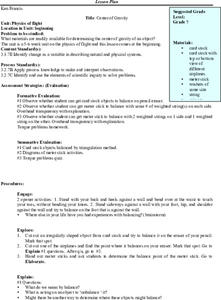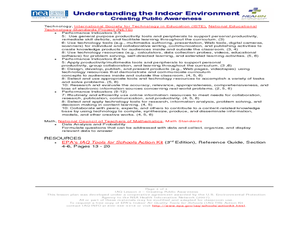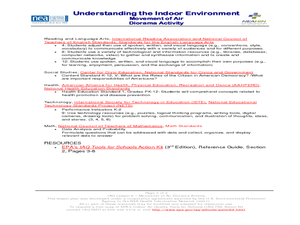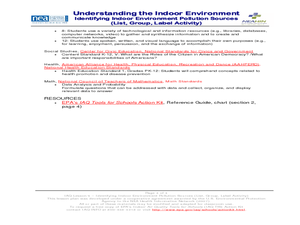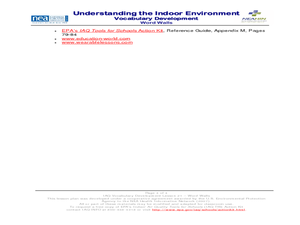Curated OER
Wetlands: Pave or Save?
Students discuss the characteristics of wetlands and how to make them more productive. Using a map, they locate the major wetlands in the United States and color them using a key. They read an article and in groups answer discussion...
Curated OER
Urban Planning: Plan a City
Students analyze the concept of urbanization by planning the placement of some of the major urban/suburban features that make up most cities. They arrange the cultural features to benefit the people who live there, and maintain respect...
Curated OER
Center of Gravity
Seventh graders determine the center of gravity of an object. They get card stock objects to balance on pencil eraser and a meter stick to balance with same # of weighted string(s) on each side. They get meter stick to balance with...
Curated OER
Help Wanted: A Lighting Engineer For Popular Rock Group
Students are assigned to groups, and determine each member's role in the group. They will design an experiment to determine a way to produce the three primary and five secondary colors. Students discuss color and mood. They listen to a...
Curated OER
Rock-a-bye Babies in a Wetland
Learners review the way human babies grow and what type of care they need. Using the internet, they are introduced to five different wetland habitat animals and how their babies grow. They discover how they are born and what the...
Curated OER
Matter Unit
Students create products from studying about matter that include: Make a "T" chart with matter and non matter items. Write a poem, song, or rap about matter. Five vocabulary words from the chapter must be included in the poem.
Curated OER
Enzymes
Tenth graders test their saliva for enzyme activity. In this enzyme lesson, 10th graders conduct an experiment to test the enzymatic activity of their saliva. They relate the lack of certain digestive enzymes with alcoholism.
Curated OER
Slippery, Slippery Ice
Students investigate how salt affects ice by experimenting in class. In this water properties instructional activity, students utilize a penny, salt and pans of ice to examine the sliding ability of a penny across a layer of ice....
Curated OER
Race the Track! Jump the Gap
Students record data of using a track system with variables and how those variables affect a ball used in the track. In this track lesson plan, students design their own track in groups, test the ball's rates of speed, and record their...
Curated OER
How Much Energy is a Kilowatt Hour?
High schoolers study the conservation of energy. In this energy lesson students explain the differences between potential and kinetic energy.
Curated OER
Simple Machines
Learners investigate simple machines. In this simple machines lesson, students explore how tools increase productivity and make life easier. Learners experiment with simple tools and discover the parts of each tool.
Curated OER
Creating Public Awareness - Indoor Air Quality
Students design a poster about indoor air quality. In this indoor air quality lesson, students make a billboard that tells the occupants of a building about at least one air quality problem.
Curated OER
Using the Problem Solving Wheel
Students solve problems about air quality. In this air quality lesson, students receive a scenario from the problem wheel and find solutions to the air quality problem. Students write a paragraph summarizing what they learned.
Curated OER
Movement of Air Diorama Activity
Learners make a diorama to illustrate the process of mechanical airflow. In this movement of air lesson plan, students discuss ventilation and air movement indoors. Learners discuss ventilation systems and study pictures of the systems....
Curated OER
Movement of Air Mind Map Activity
Students explore the movement of air. In this air lesson, students discuss and give examples of air ventilation. Students compare outdoor and indoor air quality. Students create mind maps as a visual representation of what they have...
Curated OER
Identifying Indoor Environment Pollution Sources (List, Group, Label Activity)
Students identify the cause of indoor air pollution. In this indoor air pollution lesson, students list, group, and label sources of indoor pollution. They brainstorm a list of all of the indoor pollutants they can think of before...
Curated OER
Understanding the Indoor Environment:Preventing and Fixing Indoor Air Pollution
Students explore air pollution. In this environmental studies lesson, students work with a partner to create a Venn diagram comparing and contrasting possible solutions to prevalent indoor air pollution problems. Students discuss and...
Curated OER
Invention Project
Students study air pollution and design inventions to prevent indoor environment problems. In this air pollution inventions lesson, students read about and discuss famous inventors and inventions. Students then research indoor air...
Curated OER
Deck of Word Cards
Learners study vocabulary words associated with indoor air quality. In this air quality lesson, students participate in a word card game where they write sentences for the vocabulary words given. Learners then check the original teacher...
Curated OER
Indoor Air Quality
Students make a work puzzle using air quality vocabulary. In this air quality vocabulary instructional activity, students design a word puzzle using a teacher designated number of vocabulary words. They peer edit the puzzles with their...
Curated OER
Understanding the Indoor Environment: Word Walls
Students study vocabulary words about indoor air quality. In this indoor environment lesson, students create a word wall with vocabulary words about indoor air quality and pollutants.
Curated OER
Structure of the Earth
Eighth graders explain the difference between igneous, sedimentary and metamorphic rocks. They identify the stages in the rock cycle. They discover the origin of rocks as well.
Curated OER
Our Solar System
Third graders describe the composition of our solar system. They recognize the names of the planets in our solar system and compare and contrast the nine planets that orbit the sun.
Curated OER
Kepler's 3rd Law
Learners derive the velocity in a circular orbit of any radius. They derive the Earth escape velocity and prove Kepler's 3rd law for circular orbits # A simple formula for the orbital period in a circular Earth orbit of given radius.




